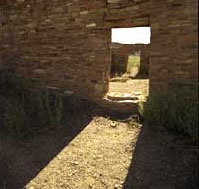The Pottery
 Look around at any of the more remote sites at Chaco Canyon and you’ll see broken pieces of ancient pottery scattered on the ground. Evidence suggests that in Chaco Canyon, clay pots replaced baskets for culinary and utility use between AD 400 and AD 750. Heavy and fragile, clay pots would have been favored by a more settled society, as opposed to a nomadic one, and their use would be consistent with growing dependence on agriculture and the building of permanent structures.
Look around at any of the more remote sites at Chaco Canyon and you’ll see broken pieces of ancient pottery scattered on the ground. Evidence suggests that in Chaco Canyon, clay pots replaced baskets for culinary and utility use between AD 400 and AD 750. Heavy and fragile, clay pots would have been favored by a more settled society, as opposed to a nomadic one, and their use would be consistent with growing dependence on agriculture and the building of permanent structures.
The carbon-containing pigments used to decorate pottery can be used to find its age, as can organic matter in the clay itself. Thanks to
carbon-14
radiometric dating
, researchers can learn the age of pottery to within plus or minus 150 years.
 Found in living things in fixed concentrations,
carbon-14
dwindles slowly after an organism dies. The half-life of carbon-14 is 5730 years, meaning that after 5730 years, half of it has decayed into
carbon-12
. Carbon-14 is then a kind of clock; measuring the amount that remains in an organic sample gives an estimate of its age.
Found in living things in fixed concentrations,
carbon-14
dwindles slowly after an organism dies. The half-life of carbon-14 is 5730 years, meaning that after 5730 years, half of it has decayed into
carbon-12
. Carbon-14 is then a kind of clock; measuring the amount that remains in an organic sample gives an estimate of its age.
The age, composition, and design of pottery can reveal much. Distinct styles of pottery are associated with distinct cultures and distinct time periods. Chaco Canyon is famous for its black-on-white pottery, but red-on-black pottery, popular in areas to the north and west, was apparently obtained by trade.
Other artifacts confirm that Chacoans engaged in a vast network of trade with other regions. Among these exotic artifacts: shells from the Pacific coast and the remains of birds—scarlet macaws—from Mexico.
Back to beginning -->

 Look around at any of the more remote sites at Chaco Canyon and you’ll see broken pieces of ancient pottery scattered on the ground. Evidence suggests that in Chaco Canyon, clay pots replaced baskets for culinary and utility use between AD 400 and AD 750. Heavy and fragile, clay pots would have been favored by a more settled society, as opposed to a nomadic one, and their use would be consistent with growing dependence on agriculture and the building of permanent structures.
Look around at any of the more remote sites at Chaco Canyon and you’ll see broken pieces of ancient pottery scattered on the ground. Evidence suggests that in Chaco Canyon, clay pots replaced baskets for culinary and utility use between AD 400 and AD 750. Heavy and fragile, clay pots would have been favored by a more settled society, as opposed to a nomadic one, and their use would be consistent with growing dependence on agriculture and the building of permanent structures.
 Found in living things in fixed concentrations,
Found in living things in fixed concentrations,